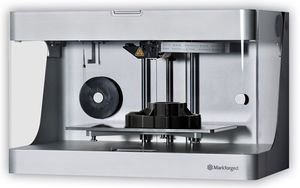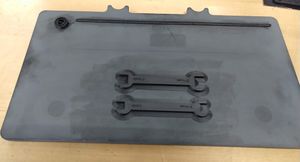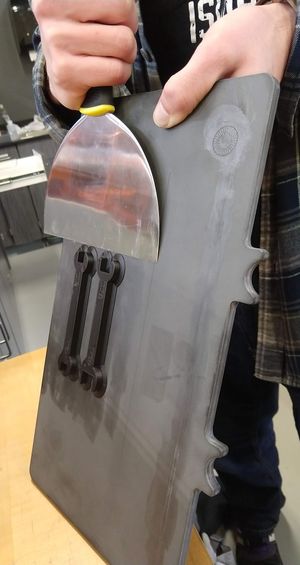Difference between revisions of "Markforged 3D Printer"
(Added summary) |
|||
| (79 intermediate revisions by 9 users not shown) | |||
| Line 3: | Line 3: | ||
|Is located in facility=Prototype Lab | |Is located in facility=Prototype Lab | ||
|Is used in domain=Electronics | |Is used in domain=Electronics | ||
| − | |Has icon=File: | + | |Has name={{PAGENAME}} |
| + | |Has make=Markforged | ||
| + | |Has model=Mark II | ||
| + | |Has serial number=70a3238c-d43a-412a-814b-3f2d8758c8b9 | ||
| + | |Has life expectancy= | ||
| + | |Has year of manufacture or purchase= | ||
| + | |Has replacement cost= | ||
| + | |Has icon=File:Mark 2 3D printer.png | ||
|Has icondesc= | |Has icondesc= | ||
|Has iconwname= | |Has iconwname= | ||
|Has image=File:mark_two.jpg | |Has image=File:mark_two.jpg | ||
|Has imagedesc=The Mark II machine by Markforged. | |Has imagedesc=The Mark II machine by Markforged. | ||
| − | |Has description= | + | |Has description= |
| − | |Has certification= | + | |Has certification=https://georgefox.instructure.com/courses/1241 |
|Has group=3D Printers | |Has group=3D Printers | ||
| − | |Has | + | |Has ace=Nathan Hayward;NHayward21@georgefox.edu |
| − | |||
}} | }} | ||
| − | [[{{#show: {{FULLPAGENAME}}|?Has icon|link=none}}| | + | [[{{#show: {{FULLPAGENAME}}|?Has icon|link=none}}|140px|left|top|{{#show: {{FULLPAGENAME}}|?Has icondesc}}]] |
| − | [[{{#show: {{FULLPAGENAME}}|?Has image|link=none}}|thumb|upright=1.5|{{#show: {{FULLPAGENAME}}|?Has imagedesc}}]] | + | [[{{#show: {{FULLPAGENAME}}|?Has image|link=none}}|300px|thumb|upright=1.5|{{#show: {{FULLPAGENAME}}|?Has imagedesc}}]] |
| − | + | ||
| − | + | Make: {{#show: {{PAGENAME}} |?Has make}} | |
| − | + | ||
| + | Model: {{#show: {{PAGENAME}} |?Has model}} | ||
| + | |||
| + | Serial Number: {{#show: {{PAGENAME}} |?Has serial number}} | ||
| + | |||
| + | Ace: {{#show: {{PAGENAME}} |?Has ace.Has name}} ({{#show: {{PAGENAME}} |?Has ace.Has email address}}). | ||
| + | |||
| + | Location: {{#show: {{PAGENAME}} |?Is located in facility}} | ||
| + | |||
| + | |||
__TOC__ | __TOC__ | ||
| − | == Documentation == | + | ==Description== |
| + | |||
| + | The Mark Two is a desktop professional 3D printer capable of reinforcing parts with composite fiber, affording them durability and strength. It can print in a range of materials, including Nylon, Carbon Fiber, Fiberglass, and Kevlar.{{#evu:https://www.youtube.com/watch?v=2o02D94B4y8&feature=youtu.be&t=26}} | ||
| + | |||
| + | ==Documentation== | ||
| + | |||
| + | ====Terminology==== | ||
| + | Inlay - embedding pieces of a different material into another, in this case embedding carbon fiber or another | ||
| + | |||
| + | Fiber - A non-plastic material which in this case comes in a strand/spool and is inlayed into the base plastic | ||
| + | |||
| + | Composite Materials - material made from two or more constituent materials with significantly different physical or chemical properties that, when combined, produce a material with characteristics different from the individual | ||
| + | |||
| + | Dry Box - dry box is a storage container in which the interior is kept at a low level of humidity, in this case in order to prevent the material from being damaged | ||
| + | |||
| + | Eiger - Software used to set up prints on the Mark Two, accessible from most browsers (i.e. Chrome). Account-based, requires an account to use. | ||
| + | |||
| + | Purge - Rapid printing of excess material which has been sitting in the machine lines for a long period of time. This helps ensure a print will be of acceptable quality by removing any potentially humidity compromised material from the lines | ||
| + | |||
| + | Onyx - Markforged prefered primary printing material. It is a vinyl base with chopped carbon fiber in the filament. | ||
| + | |||
| + | [[Media:Desktop Printer UserGuide.pdf|Markforged 3D Printer User Manual]] | ||
| + | |||
| + | [[Media:Desktop Printer QuickStartGuide.pdf|Markforged 3D Printer Quick Start Guide]] | ||
| + | |||
| + | [https://www.rdmag.com/article/2018/10/understanding-role-carbon-fiber-3d-printing Brief on Carbon Fiber Printing] | ||
| + | |||
| + | ==Training== | ||
| + | ====Operation==== | ||
| + | |||
| + | The Mark II is a [[Prototype Lab#FDM Printing|FDM Printer.]] See the main page for more background on the Fused Deposition Modeling (FDM) process. What sets the Mark II apart is its ability to inlay various materials in the print using a second nozzle. These materials include carbon fiber, fiberglass, and kevlar. These smaller materials are located on the second, smaller spool in the rear of the build space. The inlaying of these materials can be customized in Eiger (the printing software for the Markforged). The main materials for the printer are nylon and onyx, this material is contained in the dry box (black box behind the printer) in order to limit moisture contamination. Don't open this unless you need to change the material. Nylon is a typical plastic filament, which provides a clean finish and some flexibility. Onyx is nylon with chopped carbon fiber. This provides more strength and a little less flexibility. | ||
| + | |||
| + | Prints on the Markforged must be started by a manager, as the software is account based. | ||
| + | |||
| + | ====Demonstration==== | ||
| + | |||
| + | To show a complete understanding of the Mark II, student will perform the setup and shut down procedures for printing a Coiler Winder. | ||
| + | |||
| + | ====General Procedure==== | ||
| + | # Software | ||
| + | ## The Mark II utilizes cloud-based print software Eiger. This means that the software can be accessed from any browser, but an account is required to do so. As such, prints will need to be started by management. | ||
| + | ## After login, the main screen returns to library. From this page, you can view and modify previous prints for reprinting or import a new STL for printing. | ||
| + | ## Once imported or selected, print material may be selected (Onyx in this case) reinforcement type may be selected and orientation may be edited in the pane on the right. Clicking a part face will orient that face to the build plate. Reinforcement and material settings may be edited with drop-down menus (these are generally best done in the internal view). Brims and support may be toggled on or off from the Part Settings drop-down menu. All these options are available from part view. | ||
| + | ## From internal view, density (number of layers of carbon fiber) may be viewed and edited using the slider at the bottom of the page (Blue is carbon fiber, White is main material). | ||
| + | ## Material costs and totals may be viewed in the upper left of the part screen. It's worth noting the dramatic change in cost with addition of Carbon Fiber inlay. | ||
| + | ## All Mark II prints should be okay-ed with Justin Johnson (the shop supervisor) before being started. Once setup is completed and the printer is on, prints are sent to the printer via the "Print" option. Generally, select the option to start the print from the machine, rather than automatically. | ||
| + | # Printer Setup | ||
| + | ## The printer may be turned on with a switch on the rear of the machine. The machine will boot up and may need to update, let it complete this process. | ||
| + | ## Before starting the print, glue needs to be applied to the build plate. Simply lift the build plate off the mount and apply the glue stick (found in the Markforged drawer/box) to the area where the print is located in the software (be sure to account for extra width due to the brim), the back of the plate where the machine will purge a line of material (print excess material which has been sitting in the lines and exposed to air), and the corner where the purge tower is located in the image below. [[File:Mark II Build Plate.jpg|thumb|A Mark II build plate with purge tower and purge line.|none]] | ||
| + | ## Place the plate back on the mount. The Mark II is ready to print! | ||
| + | # Printer Shutdown | ||
| + | ## Upon completion of the part, select clear bed on the touchscreen and remove the build plate from the mount. The purge line and tower should be easily removable by hand. | ||
| + | ## For the part itself, take the putty knife found in the Markforged drawer/box and carefully remove the part. This may take quite a bit of force to accomplish. Make sure the blade of the putty knife and your hand will never come into contact if you slip (i.e.: brace the plate on the table and push the knife away from you along the plate). Work the knife along the perimeter of the part's attachment to the build plate and avoid prying with the knife when possible. [[File:Removing Parts from Mark II Build Plate.jpg|thumb|Removing parts from the Mark II build plate.|none]] | ||
| + | ## After the part is removed, wash the plate with warm water only. When the plate is clean, dry it with a paper towel and place it back on the mounts. | ||
| + | ## The plate is ceramic, avoid dropping it. The plate will absorb oil, it is normal to see fingerprints, etc. on the plate. | ||
| + | |||
| + | ==Safety== | ||
| + | # Please take care when removing parts from the plate so as to NOT CUT YOURSELF with the putty knife. FDM printers use heating of material to form a 3D model, like a hot glue gun. As such, the extruder head of the printer will be warm. DO NOT TOUCH THE EXTRUDER when it is hot. Doing so will result in burns. | ||
| + | # Although this should be a non-issue, fiber strands are fairly thin and sharp. DON’T IMPALE YOURSELF. | ||
| + | # The top of the printer may be opened for maintenance and inspection. This leaves the gantry with the print head on it exposed. DO NOT PUT YOUR HAND IN THE MOVING MACHINERY. Doing so may result in pinching, crushing, cutting, “ouch”-ing, crying, and other unpleasant “-ings”. | ||
| + | |||
| + | ==Approved Filaments== | ||
| + | * | ||
| + | |||
| + | ==Certification== | ||
| + | Complete the <strong>Prototype Lab - {{PAGENAME}} Module</strong> at the link below to gain access to the {{PAGENAME}}. The Maker Hub Canvas course pertains to all facilities and equipment contained in the Maker Hub; simply complete the quizzes for the facilities/equipment you wish to use in the Maker Hub. Please email <span style="color:blue">makerhub@georgefox.edu</span> if you have any questions. | ||
| + | |||
| + | [https://georgefox.instructure.com/enroll/GH36RT Maker Hub Canvas Course] | ||
| + | |||
| + | ==Troubleshooting== | ||
| + | See the the [https://support.markforged.com/hc/en-us/categories/115000131204-Mark-Two Support Page] for troubleshooting guides. | ||
| + | |||
| + | ==Maintenance== | ||
| + | ====General maintenance==== | ||
| + | |||
| + | All maintenance will be performed by the Ace of the Mark II or managers. Specific maintenance tasks are listed below. | ||
| + | ====Specific Maintenance Tasks==== | ||
| + | {| class="wikitable" | ||
| + | !Maintenance Procedure | ||
| + | !Frequency | ||
| + | !Done By | ||
| + | |- | ||
| + | |Changing Materials | ||
| + | |When needed, Use the key located in ask managers or Justin to unlock the dry box | ||
| + | |||
| + | Follow [https://support.markforged.com/hc/en-us/articles/208342553-Unload-Plastic Unload Plastic] instructions to remove what is left of current primary material. | ||
| − | + | Follow [https://support.markforged.com/hc/en-us/articles/115000403824-Set-Up-and-Load-Plastic Set Up and Load Plastic] instructions to insert new primary material. | |
| − | |||
| − | + | Follow [https://support.markforged.com/hc/en-us/articles/115000543824-Unload-Fiber Unload Fiber] instructions to remove what is left of current inlay material. | |
| − | |||
| − | + | Follow [https://support.markforged.com/hc/en-us/articles/208198473-Set-Up-and-Load-Fiber Set Up and Load Fiber] instructions to insert new primary material. | |
| − | + | |Ace or Managers | |
| − | + | |- | |
| + | |Calibration and Setup | ||
| + | |Follow [https://support.markforged.com/hc/en-us/articles/207896386-Level-the-Print-Bed Level the Print Bed] instructions to level the print bed and set the correct nozzle heights. | ||
| + | |Ace or managers | ||
| + | |- | ||
| + | |Additional Calibration and Maintenance | ||
| + | |See the [https://support.markforged.com/hc/en-us/categories/115000131204-Mark-Two Support Page] for additional maintenance and operation guides. | ||
| + | |Ace or managers | ||
| + | |} | ||
<references /> | <references /> | ||
Latest revision as of 14:01, 22 August 2024
Make: Markforged
Model: Mark II
Serial Number: 70a3238c-d43a-412a-814b-3f2d8758c8b9
Ace: Nathan Hayward (NHayward21@georgefox.edu).
Location: Prototype Lab
Description
The Mark Two is a desktop professional 3D printer capable of reinforcing parts with composite fiber, affording them durability and strength. It can print in a range of materials, including Nylon, Carbon Fiber, Fiberglass, and Kevlar.
Documentation
Terminology
Inlay - embedding pieces of a different material into another, in this case embedding carbon fiber or another
Fiber - A non-plastic material which in this case comes in a strand/spool and is inlayed into the base plastic
Composite Materials - material made from two or more constituent materials with significantly different physical or chemical properties that, when combined, produce a material with characteristics different from the individual
Dry Box - dry box is a storage container in which the interior is kept at a low level of humidity, in this case in order to prevent the material from being damaged
Eiger - Software used to set up prints on the Mark Two, accessible from most browsers (i.e. Chrome). Account-based, requires an account to use.
Purge - Rapid printing of excess material which has been sitting in the machine lines for a long period of time. This helps ensure a print will be of acceptable quality by removing any potentially humidity compromised material from the lines
Onyx - Markforged prefered primary printing material. It is a vinyl base with chopped carbon fiber in the filament.
Markforged 3D Printer User Manual
Markforged 3D Printer Quick Start Guide
Brief on Carbon Fiber Printing
Training
Operation
The Mark II is a FDM Printer. See the main page for more background on the Fused Deposition Modeling (FDM) process. What sets the Mark II apart is its ability to inlay various materials in the print using a second nozzle. These materials include carbon fiber, fiberglass, and kevlar. These smaller materials are located on the second, smaller spool in the rear of the build space. The inlaying of these materials can be customized in Eiger (the printing software for the Markforged). The main materials for the printer are nylon and onyx, this material is contained in the dry box (black box behind the printer) in order to limit moisture contamination. Don't open this unless you need to change the material. Nylon is a typical plastic filament, which provides a clean finish and some flexibility. Onyx is nylon with chopped carbon fiber. This provides more strength and a little less flexibility.
Prints on the Markforged must be started by a manager, as the software is account based.
Demonstration
To show a complete understanding of the Mark II, student will perform the setup and shut down procedures for printing a Coiler Winder.
General Procedure
- Software
- The Mark II utilizes cloud-based print software Eiger. This means that the software can be accessed from any browser, but an account is required to do so. As such, prints will need to be started by management.
- After login, the main screen returns to library. From this page, you can view and modify previous prints for reprinting or import a new STL for printing.
- Once imported or selected, print material may be selected (Onyx in this case) reinforcement type may be selected and orientation may be edited in the pane on the right. Clicking a part face will orient that face to the build plate. Reinforcement and material settings may be edited with drop-down menus (these are generally best done in the internal view). Brims and support may be toggled on or off from the Part Settings drop-down menu. All these options are available from part view.
- From internal view, density (number of layers of carbon fiber) may be viewed and edited using the slider at the bottom of the page (Blue is carbon fiber, White is main material).
- Material costs and totals may be viewed in the upper left of the part screen. It's worth noting the dramatic change in cost with addition of Carbon Fiber inlay.
- All Mark II prints should be okay-ed with Justin Johnson (the shop supervisor) before being started. Once setup is completed and the printer is on, prints are sent to the printer via the "Print" option. Generally, select the option to start the print from the machine, rather than automatically.
- Printer Setup
- The printer may be turned on with a switch on the rear of the machine. The machine will boot up and may need to update, let it complete this process.
- Before starting the print, glue needs to be applied to the build plate. Simply lift the build plate off the mount and apply the glue stick (found in the Markforged drawer/box) to the area where the print is located in the software (be sure to account for extra width due to the brim), the back of the plate where the machine will purge a line of material (print excess material which has been sitting in the lines and exposed to air), and the corner where the purge tower is located in the image below.
- Place the plate back on the mount. The Mark II is ready to print!
- Printer Shutdown
- Upon completion of the part, select clear bed on the touchscreen and remove the build plate from the mount. The purge line and tower should be easily removable by hand.
- For the part itself, take the putty knife found in the Markforged drawer/box and carefully remove the part. This may take quite a bit of force to accomplish. Make sure the blade of the putty knife and your hand will never come into contact if you slip (i.e.: brace the plate on the table and push the knife away from you along the plate). Work the knife along the perimeter of the part's attachment to the build plate and avoid prying with the knife when possible.
- After the part is removed, wash the plate with warm water only. When the plate is clean, dry it with a paper towel and place it back on the mounts.
- The plate is ceramic, avoid dropping it. The plate will absorb oil, it is normal to see fingerprints, etc. on the plate.
Safety
- Please take care when removing parts from the plate so as to NOT CUT YOURSELF with the putty knife. FDM printers use heating of material to form a 3D model, like a hot glue gun. As such, the extruder head of the printer will be warm. DO NOT TOUCH THE EXTRUDER when it is hot. Doing so will result in burns.
- Although this should be a non-issue, fiber strands are fairly thin and sharp. DON’T IMPALE YOURSELF.
- The top of the printer may be opened for maintenance and inspection. This leaves the gantry with the print head on it exposed. DO NOT PUT YOUR HAND IN THE MOVING MACHINERY. Doing so may result in pinching, crushing, cutting, “ouch”-ing, crying, and other unpleasant “-ings”.
Approved Filaments
Certification
Complete the Prototype Lab - Markforged 3D Printer Module at the link below to gain access to the Markforged 3D Printer. The Maker Hub Canvas course pertains to all facilities and equipment contained in the Maker Hub; simply complete the quizzes for the facilities/equipment you wish to use in the Maker Hub. Please email makerhub@georgefox.edu if you have any questions.
Troubleshooting
See the the Support Page for troubleshooting guides.
Maintenance
General maintenance
All maintenance will be performed by the Ace of the Mark II or managers. Specific maintenance tasks are listed below.
Specific Maintenance Tasks
| Maintenance Procedure | Frequency | Done By |
|---|---|---|
| Changing Materials | When needed, Use the key located in ask managers or Justin to unlock the dry box
Follow Unload Plastic instructions to remove what is left of current primary material. Follow Set Up and Load Plastic instructions to insert new primary material. Follow Unload Fiber instructions to remove what is left of current inlay material. Follow Set Up and Load Fiber instructions to insert new primary material. |
Ace or Managers |
| Calibration and Setup | Follow Level the Print Bed instructions to level the print bed and set the correct nozzle heights. | Ace or managers |
| Additional Calibration and Maintenance | See the Support Page for additional maintenance and operation guides. | Ace or managers |



